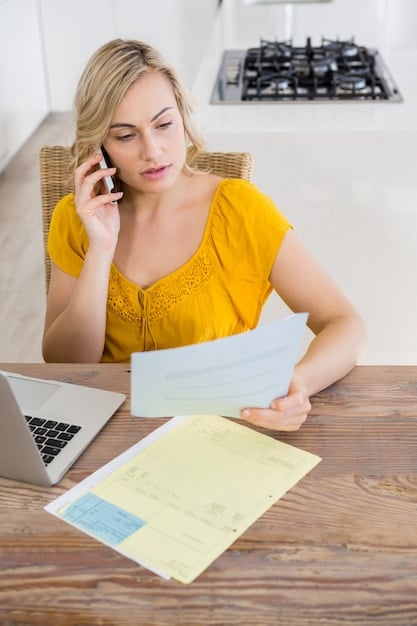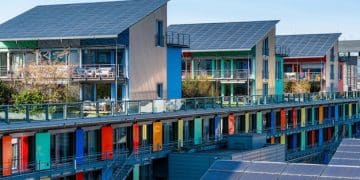Energy Assistance Programs for Renters: Save Up to 25% on Bills

Energy assistance programs for renters provide crucial support by helping to lower utility bills, offering potential savings of up to 25% for eligible households, thereby easing the financial burden of housing costs.
Are you a renter struggling with high utility bills? You’re not alone. Many renters face challenges in managing their energy expenses, but thankfully, numerous energy assistance programs for renters are available to help reduce your financial burden and potentially cut your utility bills by up to 25%.
Understanding energy assistance programs for renters
Energy assistance programs are designed to help low-income households afford their energy bills. These programs are particularly beneficial for renters, who often have limited control over the energy efficiency of their homes.
Who qualifies for energy assistance?
Eligibility criteria vary by program, but generally, these programs target households with incomes below a certain threshold, often based on the federal poverty level. Factors like household size and energy burden (the percentage of income spent on energy bills) are also considered.
Types of energy assistance available
Energy assistance can take various forms, including:
- Bill payment assistance: Direct financial aid to help pay current or past-due energy bills.
- Weatherization assistance: Home improvements to increase energy efficiency, such as insulation, window repairs, and appliance upgrades.
- Energy crisis assistance: Emergency aid to prevent disconnection of utility services during extreme weather events.
Different programs may offer different types and levels of assistance. Understanding the options available in your area is crucial.
Understanding energy saving programs and who qualifies assists renters in accessing the support they need to reduce energy costs.

Navigating the LIHEAP program for renters
The Low Income Home Energy Assistance Program (LIHEAP) is a federally funded program that helps low-income households with their energy bills. LIHEAP is administered by individual states, so eligibility criteria and benefit levels may vary.
LIHEAP eligibility for renters
Renters are generally eligible for LIHEAP if they meet income requirements. In some cases, renters whose utility costs are included in their rent may also be eligible, especially if they can demonstrate a separate energy burden.
How to apply for LIHEAP
The application process for LIHEAP typically involves:
- Contacting your state or local LIHEAP agency.
- Gathering required documentation, such as proof of income, identification, and energy bills.
- Completing an application form and submitting it to the agency.
Maximizing your LIHEAP benefits
To get the most out of your LIHEAP benefits, consider:
- Applying early in the season, as funds may be limited.
- Exploring additional energy assistance programs that can supplement LIHEAP.
- Taking steps to reduce your energy consumption through energy-efficient practices.
Navigating LIHEAP requires understanding the specific rules and procedures in your state to secure essential energy assistance.
Exploring state and local energy assistance programs
In addition to LIHEAP, many states and local communities offer their own energy assistance programs for renters. These programs may have different eligibility criteria and benefits than LIHEAP.

Researching available programs
Finding state and local energy assistance programs involves:
- Checking with your state’s energy office or department of social services.
- Contacting your local community action agency or United Way chapter.
- Searching online for energy assistance programs in your city or county.
Understanding program requirements
State and local programs may have specific requirements, such as:
- Residency requirements: You may need to be a resident of the state or locality to be eligible.
- Income limits: Programs may have different income thresholds than LIHEAP.
- Energy usage criteria: Some programs may require you to demonstrate a certain level of energy consumption.
Combining programs for maximum impact
It’s often possible to combine benefits from multiple energy assistance programs to increase your overall savings. Check with each program to see if they allow stacking benefits.
Exploring state and local energy programs can reveal additional resources that complement federal assistance, thereby increasing the overall financial relief for renters.
Energy efficiency tips for renters
Even with energy assistance, reducing your energy consumption is the best way to lower your utility bills. Renters can implement various energy-efficient practices without making permanent changes to their homes.
Low-cost or no-cost energy-saving measures
Here are some simple steps you can take to reduce your energy usage:
- Seal drafts around windows and doors with weather stripping or caulk.
- Use energy-efficient light bulbs, such as LEDs.
- Unplug electronics when not in use to avoid phantom energy drain.
Working with your landlord
Communicate with your landlord about energy efficiency improvements:
- Request energy-efficient appliances or upgrades if your landlord is willing.
- Ask about the possibility of adding insulation or sealing windows.
- Encourage your landlord to participate in energy efficiency programs for rental properties.
Understanding your lease agreement
Review your lease agreement to understand your responsibilities for energy usage and costs. Some leases may include clauses about energy efficiency or limitations on appliance usage.
By implementing these steps, renters can reduce energy consumption to further lower utility expenses.
Common challenges and solutions for renters
Renters often face unique challenges when trying to access energy assistance or improve energy efficiency. Understanding these challenges and their solutions is crucial for navigating the system.
Challenge: Proof of residency and utility responsibility
Solution: Provide a copy of your lease agreement to prove residency. If utilities are in your landlord’s name, obtain a letter from them confirming your utility responsibility.
Challenge: Landlord restrictions on energy efficiency improvements
Solution: Communicate with your landlord about the benefits of energy efficiency improvements and offer to share the cost or provide labor if possible.
Challenge: Limited control over appliances and systems
Solution: Focus on energy-efficient practices that don’t require altering appliances or systems, such as using energy-efficient light bulbs and unplugging electronics.
Addressing these challenges assists renters in effectively accessing energy assistance programs so they can improve their energy efficiency.
Long-term benefits of energy assistance
Energy assistance programs provide immediate relief from high energy bills, but they also offer long-term benefits for renters.
Improved financial stability
Reducing energy costs can free up income for other essential needs, such as food, healthcare, and transportation. This can lead to improved financial stability and reduced stress.
Increased housing affordability
By making housing more affordable, energy assistance can help renters stay in their homes and avoid displacement. This is particularly important for low-income families and vulnerable populations.
Health and well-being
Stable and affordable housing can improve health and well-being by reducing stress, improving access to healthcare, and creating a more stable living environment.
The long-term benefits of energy assistance extend beyond immediate financial relief and can affect overall well-being.
| Key Point | Brief Description |
|---|---|
| 💡LIHEAP | Federal program assisting with energy bills. |
| 🏠 State & Local Programs | Additional assistance at the state and local levels. |
| 💰 Energy Efficiency | Simple steps to cut down energy usage. |
| 🔑 Eligibility | Income limits and residency requirements vary. |
Frequently Asked Questions
▼
LIHEAP, or the Low Income Home Energy Assistance Program, is a federally funded program that helps low-income households with their energy bills. It is administered by individual states.
▼
Contact your state or local LIHEAP agency to start the application process. You’ll need documentation like proof of income, ID, and energy bills.
▼
Yes, you can often combine benefits from multiple programs. Check with each program to confirm stacking benefits policies.
▼
Even if utilities are included in your rent, you may be eligible for assistance if you can demonstrate your energy burden.
▼
Seal drafts, use LEDs, and unplug electronics, or ask about what efficiency improvements your landlord is willing to make to the building.
Conclusion
In conclusion, **energy assistance programs for renters** provide essential support for managing energy costs and improving financial stability. By understanding the available programs, implementing energy-efficient practices, and addressing common challenges, renters can reduce their utility bills by up to 25% and create a more affordable and sustainable living environment. Don’t hesitate to explore all options and take advantage of these valuable resources.





